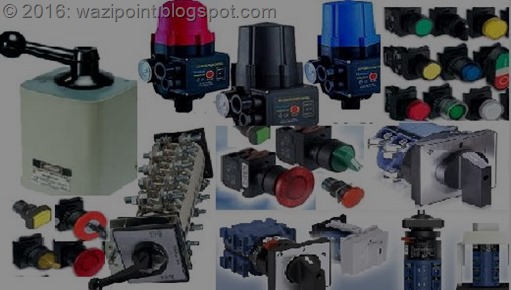Electrical Control, Selector and Auxiliary Switches
Electrical Engineering defines a switch is an electrical device for an electrical circuit to make or break, interrupt or divert the current flow from one conductor to another.
Electrical switch is a very wide range of electrical component sect that control consisting electrical, mechanical, electronic, even more latest micro component devices for making, breaking or changing the circuit connection.
Switches Types
From different point of concept we also can say more about electrical switches- an electrical switching mechanism that controls the operation of a machine is known as control switch or controller; an electrical switch that uses to select for any alternative from provided is known as selector or selector switch; Heavy loaded equipment directly switching is not safe to use line current and voltage, these are operate by some auxiliary devised switches are known as auxiliary switch; an electrical switch that uses for reversing the direction of electric current is known as switch commutator; an electrical device that interrupt electrical continuation is known as cutout switch or fuse; an electrical switch that operates by setting a time device is known as time switch; a switch that operate the solenoid to ignite or starter is known as ignition switch; There are so many electrical switches like push button switch, toggle switch, on-off switch etc..
Switch Selection Criteria and Guideline to Execute an Electrical Construction Project
This guide will show how to select electrical control switch, selector switch and auxiliary switch to execute an electrical construction project by a service provider ensuring national and international standard.
Here below considering al control switches, selector switches and auxiliary switches for construction a high voltage power transmission project. Described switches are used in power grid substation control and switching equipment.
Control Switches
Control switches should be of the three-position type with a spring return action to a central position and without a locking feature.
Circuit Breakers should have control switches which should be labeled open/N/close or (O/N/I) and arranged to operate clockwise when closing the circuit breakers and anti-clockwise when opening them, and should be of the pistol grip type.
Control switches of the discrepancy type should be provided where specified, i.e. mimic panel. Such discrepancy control switches should be arranged in the lines of the mimic diagram. Such switches should include lamps and be of the manually operated pattern, spring loaded such that it is necessary to push and twist the switch past indicating position for operation. The lamp should be incorporated in the switch base and should flash whenever the position of the circuit breaker is at variance with the position indicated by the control switch. Hand dressing of the control switch to the correct position should cause the lamp to extinguish.
Selector Switches
Selector switches should be of the two or more position type as required, and have a stay-put action to remain in any selected position which should be lockable and separate padlocks each with duplicate keys should be provided. Each position of the selector switches should be suitably labeled to denote their function. The switch handle should be of the pistol grip type to the approval of the Engineer.
It should not be possible at any time to operate any switchgear equipment from more than one location simultaneously, and suitable lockable selector switches should be provided to meet this requirement.
The contacts of all control and selector switches should be shrouded to minimize the ingress of dust and accidental contact, and should be amply rated for voltage and current for the circuits in which they are used.
Auxiliary Switches
Auxiliary switches should be to approval and contacts should have a positive wiping action when closing.
All auxiliary switches, whether in service or not in the first instance, should be wired up to a terminal board and should be arranged in the same sequence on similar equipment.
Auxiliary switches mechanically operated by the circuit breakers, contactors, isolators, etc. should be to approval and contacts mounted in accessible positions clear of the operating mechanism of the circuit breaker, contactor, isolator, etc. and they should be adequately protected against accidental electrical shock.
Auxiliary switches should be provided to interrupt the supply of current to the trip coil of each circuit breaker and contactor immediately the breaker or contactor has opened. These auxiliary switches should make before the main contacts, during a closing operation.
A minimum four spare auxiliary switches, two normally open, two normally closed should be provided for each circuit breaker, and contactors and also for isolators.
Final Talk about Switches
It strange to finish the talk about switches in a single article, but at least we understood in a simple that an electrical switch makes either completely on “closed” or completely off “open” to operate an electrical circuit.






Looking for the best electrical switches in India? Look no further than Norisys electrical switch Norisys electrical switch. Our high-quality and reliable switches are designed to meet all your electrical needs, providing efficient and safe performance for your home or business. Trust Norisys for the best electrical switches that guarantee maximum safety and durability.
ReplyDeleteYou Can Call Us For More Info:- +91 9560024771
Visit Our Website:- switch socket accessories